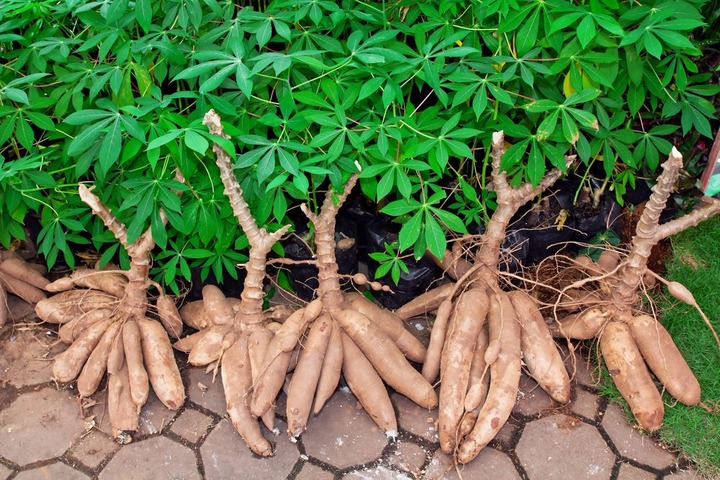Vielleicht werden Sie sich fragen “Was ist Maniok?”, bevor Sie an seine Nachteile denken. Aber angesichts seiner erstaunlichen Eigenschaften kann diese ziemlich süße, stärkehaltige und nussartige Knolle ein Grundnahrungsmittel in Ihrer Speisekammer werden.
Kassave (Manihot esculenta), auch bekannt als Maniok oder Yuca (nicht Yucca), gehört zur Familie der Wolfsmilchgewächse, die Euphorbiaceae genannt wird. Es ist wahrscheinlich in südamerikanischen Waldgebieten entstanden, aber es ist auch populär in Asien, Afrika und südlicher USA. Seit Jahrhunderten ist es eine Nahrungsgrundlage für Millionen Menschen.
Laut des Hongkonger Zentrum für Lebensmittelsicherheit enthält Maniok mehr als eine Form von cyanogenen Glykosiden – süß und bitter:
“Verschiedene Manioksorten werden im Allgemeinen in zwei Haupttypen eingeteilt: süßer Maniok und bitterer Maniok. In süßer Maniokwurzeln befindet sich weniger als 50 mg pro Kilogramm Blausäure auf Frischgewichtbasis, während in der Bittersorte es bei 400 mg pro Kilogramm liegt.”
Maniok ist eine Staude, die normalerweise in tropischen Klimazonen angebaut wird und sich sehr einfach durch die Verwendung eines abgeschnittenen Teils des Stängels fortpflanzt. Seine Wurzeln (ähnlich wie große Yams) können mehrere Pfund wiegen. Sie haben harte, schuppige und braune Haut und stärkehaltiges, weißes “Fleisch” im Inneren. Doch bei der Ernte muss man sie vorsichtig nehmen, denn die Haltbarkeit nur wenige Tage dauert.
Sie können die Maniokwurzeln (oder Mehl) in großen Lebensmitteln ganz einfach kaufen und diese bei Raumtemperatur für eine Woche lang einlagern. Nach dem Peeling kann man ihn siedeln, backen, braten, trocken für spätere Verwendung oder fermentieren.
Die Blätter werden auch für Nahrung verwendet und enthalten 100 mal Protein mehr als die Wurzel, aber beide müssen gekocht und das Wasser verworfen werden.
Die seltsamen und nützliches Vorteile vom Maniok
Obwohl im Innere Maniokwurzeln wie weiße Kartoffeln aussieht, besitzt Maniok fast die doppelte Menge von Kalorien. Dies kann möglicherweise die kalorienreichste Knolle bis jetzt sein. Eine Tasse gekochter Maniok ergibt sich 330 Kalorien, 78 Gramm Kohlenhydrate, 3 Gramm Protein, 4 Gramm Ballaststoffe und Zucker.
Da es von Natur aus glutenfrei ist, ist Maniok für Zöliakiepatienten und andere, die versuchen, Gluten zu vermeiden, äußerst nützlich. Ein Aspekt von Maniok ist, dass es eines von mehreren Grundnahrungsmitteln ist, die vom Department of Science and Technology der Philippinen definiert wurden und einen niedrigen glykämischen Index (GI) haben und daher gut für Diabetiker sind.
Being naturally gluten-free, cassava is extremely useful for celiac patients and others trying to avoid gluten. One aspect of cassava is that it’s one of several root foods defined by the Philippines’ Department of Science and Technology as having a low glycemic index(GI) and therefore good for diabetics.
“GI is a classification of food based on the blood glucose response to a food relative to a standard glucose solution. Low glycemic foods control the release of glucose into the bloodstream at a steady and sustained rate, keeping the body’s metabolic processes and energy levels balanced.
People with low glycemic diets or [who] eat low glycemic foods are said to have lower risk of getting coronary heart disease and type 2 diabetes.
These food items that have low GI would benefit those who are already suffering from diabetes, since these would help in the proper control and management of blood sugar.”4
As a low-GI food, eating cassava can also help improve physical endurance because blood glucose levels are moderated instead of dropping when insulin is produced.
Low-GI foods also may help control triglyceride and other lipid levels in your blood. Cassava has even been called a “weight loss wonder food” due to its ability to decrease appetite and decrease fat storage in fat cells.5
B-complex vitamins contained in cassava include folate, thiamin, pyridoxine (vitamin B6), pantothenic acid (vitamin B5) and riboflavin (vitamin B2). The root also includes a number of minerals that perform important functions throughout your body:
| Iron helps form the two proteins responsible for transporting oxygen to your tissues | Zinc helps your immune system fight bacteria and aids cell growth and division | Calcium helps form strong bones and teeth |
| Magnesium optimizes mitochondrial function and helps regulate blood sugar | Potassium synthesizes proteins and helps break down carbohydrates | Manganese is vital for connective tissue and sex hormones, and repairing joints |
Cassava also contains saponins that can ease inflammation, break down organic body wastes like uric acid, cleanse mineral deposits from your joints and help balance your gut flora.
Tapioca: Starch From the Cassava Root
If you’ve ever had tapioca, you’ve had a form of cassava, as tapioca is the starchy liquid extracted from the root; cassava is the ground root itself. The content is essentially pure carbohydrates, with negligible fiber, protein or nutrients. In fact, one study called tapioca “nutritionally inferior.”6
One cup of dry pearl tapioca contains 544 calories, 135 grams of carbohydrates and 5 grams of sugar. There are virtually no vitamins to speak of, other than a small amount of folate and pantothenic acid, but the same amount yields 13 percent of the recommended daily value in iron and 8 percent of the manganese.7
Moisture is removed from the root either by evaporation or squeezing it out after being ground, leaving a fine, white powder. Dried, it’s often sold as flour or pressed into flakes or “pearls,” which should be boiled before you eat them; 1 part dry pearls to 8 parts water is a good ratio.
The product usually resembles small, translucent and gel-like balls with a leathery consistency that expand when moisture is added. Especially as a need for gluten-free options have emerged into the mainstream diet, tapioca is one of the best alternatives to wheat and other grains.
While tapioca starch provides energy with very little nutritional value, it’s gluten-free, which is worth its weight in gold to a growing number of people who are allergic or sensitive to gluten.8 It also has several uses in place of flour for both cooking and baking:
- Tapioca makes a popular type of pudding made up of chewy, mildly sweet “pearls,” as well as bubble tea, an Asian concoction usually served cold.
- Gluten- and grain-free bread made from tapioca is sometimes combined with other flours such as coconut flour or almond meal to improve the nutrition.
- As a thickener, tapioca is excellent for bulking up the consistency of soups or stews, and it’s essentially flavorless.
- Flatbread made from tapioca is most often found in developing countries because it’s inexpensive and very versatile.
- Added to burgers and dough, tapioca is a binder that can improve the texture and moisture content in foods without becoming soggy.
Cassava: A Digestive-Resistant Starch
The Healthy Home Economist calls resistant starch “the healthiest starch for your gut:”
“Resistant starch is a type of starch that does not break down (it literally “resists” digestion), instead of being absorbed as glucose like most starches.
Instead, resistant starch travels through the small intestine to the colon where it is turned into beneficial, energy-boosting, inflammation-squashing and short-chain fatty acids by intestinal bacteria.
The main reason why resistant starch is so beneficial is that it feeds the friendly bacteria in your colon, turns them into important short chain fatty acids, such as butyrate (known to help reduce inflammation) and is extremely helpful in cases of autoimmunity, IBS, colitis and allergies.”9
According to Authority Nutrition:
“Most of the carbohydrates in the diet are starches. Starches are long chains of glucose that are found in grains, potatoes and various foods. But not all of the starch we eat gets digested. Sometimes a small part of it passes through the digestive tract unchanged. In other words, it is resistant to digestion.”10
Resistant starch can be very beneficial. As it feeds beneficial gut bacteria, it can reduce inflammation as well as harmful bacteria.11
It may also lower your blood glucose level after meals,12 improve insulin sensitivity,13 help manage metabolic syndrome14 and possibly help you eat less.15 The four different types of resistant starches include:16
- Type 1, found in grains, seeds and legumes, resists digestion because it’s bound by fibrous cell walls.
- Type 2 is indigestible starchy foods such as green bananas and raw potatoes which, when heated, makes them digestible.
- Type 3 is created when a starchy food is cooked, then cooled, turning some digestible starches, such as rice and white beans, into resistant starch through retrogradation.17
- Type 4 is a man-made substance using a chemical process and is not healthy for you.
Other Uses for Cassava
Cassava is also known for many additional benefits, according to StyleCraze:18
| Cassava made into a simple paste with water and used as a peel or scrub smoothes, brightens and hydrates your skin. | As a mask, wash your face first with warm water, smooth on a paste using water and honey, dry completely and rinse well with cold water. |
| Cassava roots and leaves can be made into a paste to nourish and soften your hair and remedy hair loss. Twice a week, apply coconut or olive oil, then cassava paste, wait one hour and rinse. | Traditionally, the roots and leaves were used to boost immunity, energy and brain function, heal wounds, de-worm, soothe headaches and fevers, aid digestion and rheumatoid conditions, lower blood pressure and balance stress levels. |
Precautions Regarding Cassava
Cassava roots contain the toxic compound linamarin, which converts to hydrogen cyanide. Improper cooking of cassava root is associated with cyanide poisoning, which can cause symptoms of vomiting, nausea, dizziness, stomach pains, headache, irreversible paralysis from a disease called konzo19 and even death. Nutrition and You noted:
“Cassava should never be eaten raw as the root composes [sic] small quantities of cyanogenic glycosides, especially hydroxycyanic acid. Cyanide compounds interfere with cellular metabolism by inhibiting the cytochrome-oxidase enzyme inside the human body.”20
However, if the cassava are peeled and cooked, toxic substances are removed. It should be noted that the tapioca you buy at the store or prepare from a package does not contain harmful cyanide levels, so it’s perfectly safe to eat.
Vom Dr. Mercola
Quelle: https://articles.mercola.com/sites/articles/archive/2016/07/25/cassava-benefits.aspx

